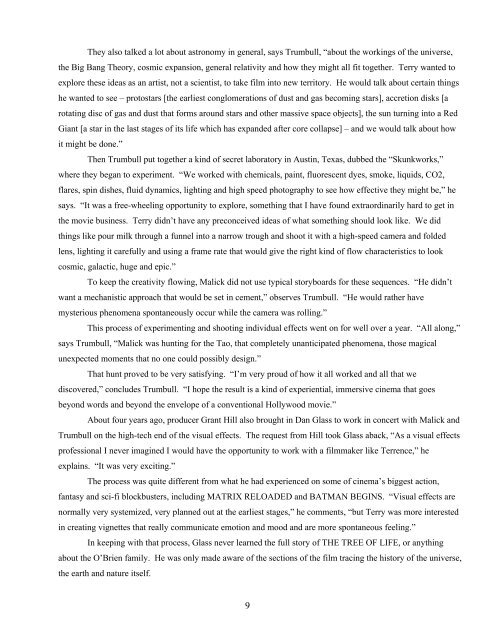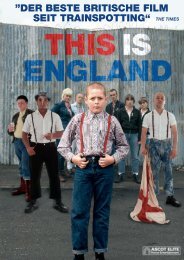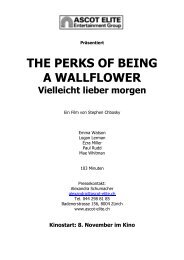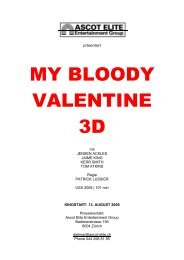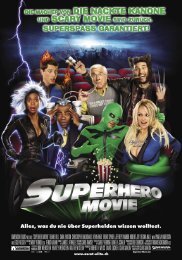RIVER ROAD ENTERTAINMENT Presents BRAD PITT SEAN PENN ...
RIVER ROAD ENTERTAINMENT Presents BRAD PITT SEAN PENN ...
RIVER ROAD ENTERTAINMENT Presents BRAD PITT SEAN PENN ...
Create successful ePaper yourself
Turn your PDF publications into a flip-book with our unique Google optimized e-Paper software.
They also talked a lot about astronomy in general, says Trumbull, “about the workings of the universe,<br />
the Big Bang Theory, cosmic expansion, general relativity and how they might all fit together. Terry wanted to<br />
explore these ideas as an artist, not a scientist, to take film into new territory. He would talk about certain things<br />
he wanted to see – protostars [the earliest conglomerations of dust and gas becoming stars], accretion disks [a<br />
rotating disc of gas and dust that forms around stars and other massive space objects], the sun turning into a Red<br />
Giant [a star in the last stages of its life which has expanded after core collapse] – and we would talk about how<br />
it might be done.”<br />
Then Trumbull put together a kind of secret laboratory in Austin, Texas, dubbed the “Skunkworks,”<br />
where they began to experiment. “We worked with chemicals, paint, fluorescent dyes, smoke, liquids, CO2,<br />
flares, spin dishes, fluid dynamics, lighting and high speed photography to see how effective they might be,” he<br />
says. “It was a free-wheeling opportunity to explore, something that I have found extraordinarily hard to get in<br />
the movie business. Terry didn’t have any preconceived ideas of what something should look like. We did<br />
things like pour milk through a funnel into a narrow trough and shoot it with a high-speed camera and folded<br />
lens, lighting it carefully and using a frame rate that would give the right kind of flow characteristics to look<br />
cosmic, galactic, huge and epic.”<br />
To keep the creativity flowing, Malick did not use typical storyboards for these sequences. “He didn’t<br />
want a mechanistic approach that would be set in cement,” observes Trumbull. “He would rather have<br />
mysterious phenomena spontaneously occur while the camera was rolling.”<br />
This process of experimenting and shooting individual effects went on for well over a year. “All along,”<br />
says Trumbull, “Malick was hunting for the Tao, that completely unanticipated phenomena, those magical<br />
unexpected moments that no one could possibly design.”<br />
That hunt proved to be very satisfying. “I’m very proud of how it all worked and all that we<br />
discovered,” concludes Trumbull. “I hope the result is a kind of experiential, immersive cinema that goes<br />
beyond words and beyond the envelope of a conventional Hollywood movie.”<br />
About four years ago, producer Grant Hill also brought in Dan Glass to work in concert with Malick and<br />
Trumbull on the high-tech end of the visual effects. The request from Hill took Glass aback, “As a visual effects<br />
professional I never imagined I would have the opportunity to work with a filmmaker like Terrence,” he<br />
explains. “It was very exciting.”<br />
The process was quite different from what he had experienced on some of cinema’s biggest action,<br />
fantasy and sci-fi blockbusters, including MATRIX RELOADED and BATMAN BEGINS. “Visual effects are<br />
normally very systemized, very planned out at the earliest stages,” he comments, “but Terry was more interested<br />
in creating vignettes that really communicate emotion and mood and are more spontaneous feeling.”<br />
In keeping with that process, Glass never learned the full story of THE TREE OF LIFE, or anything<br />
about the O’Brien family. He was only made aware of the sections of the film tracing the history of the universe,<br />
the earth and nature itself.<br />
9


